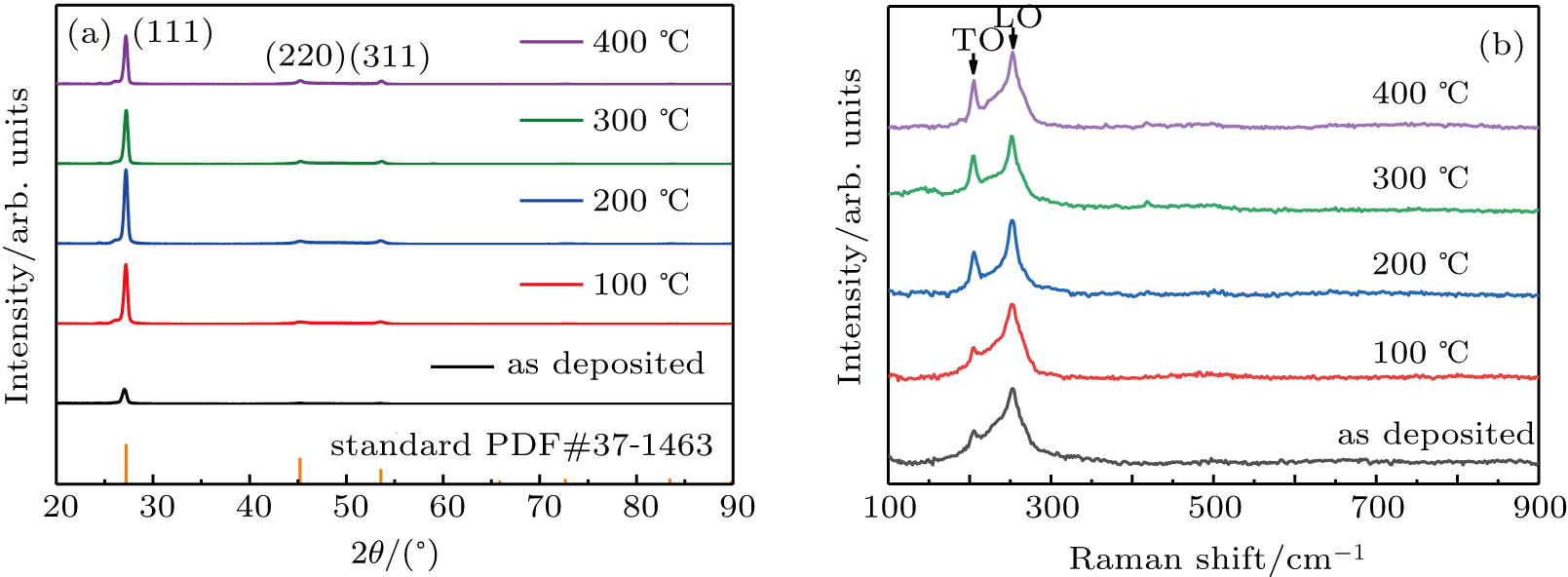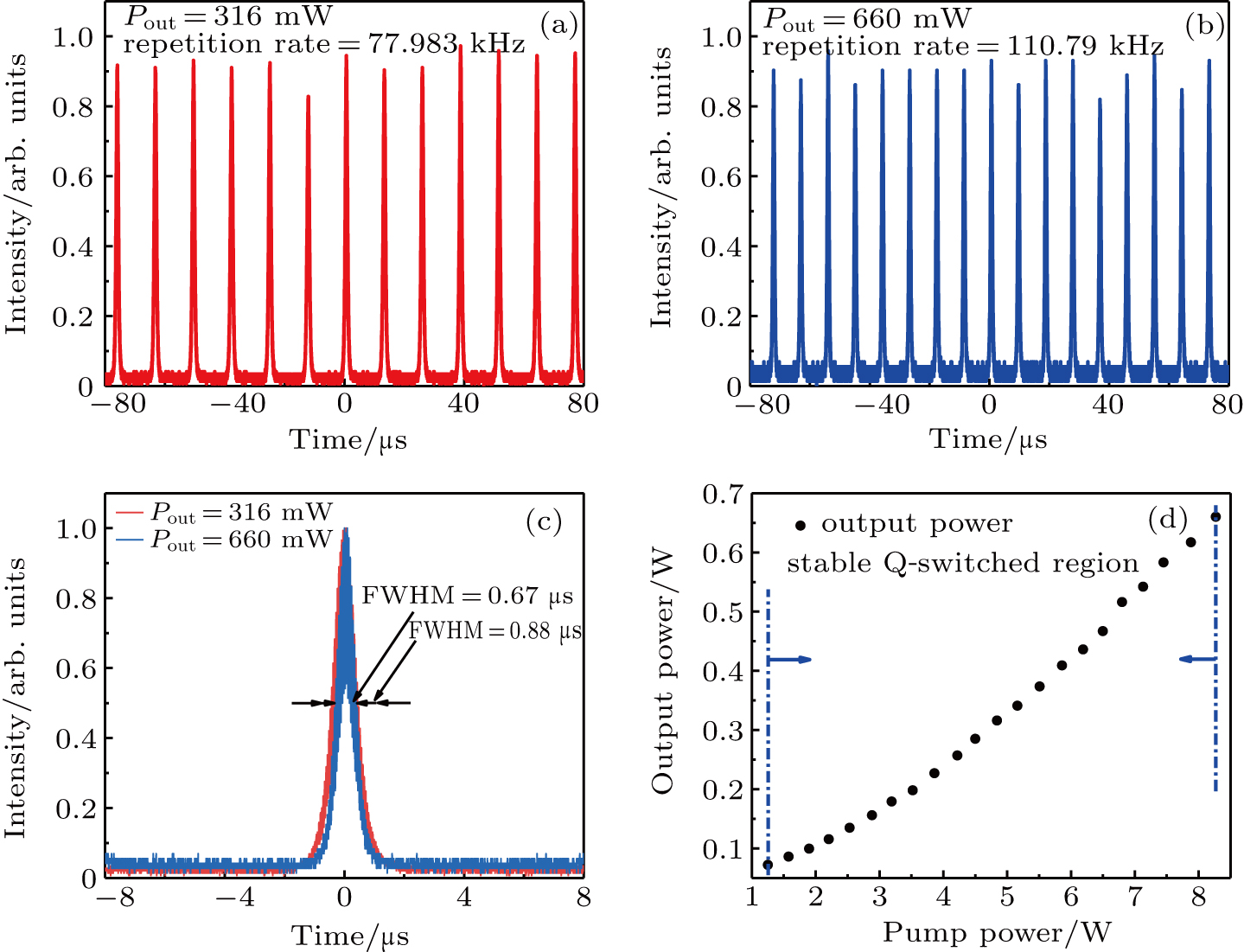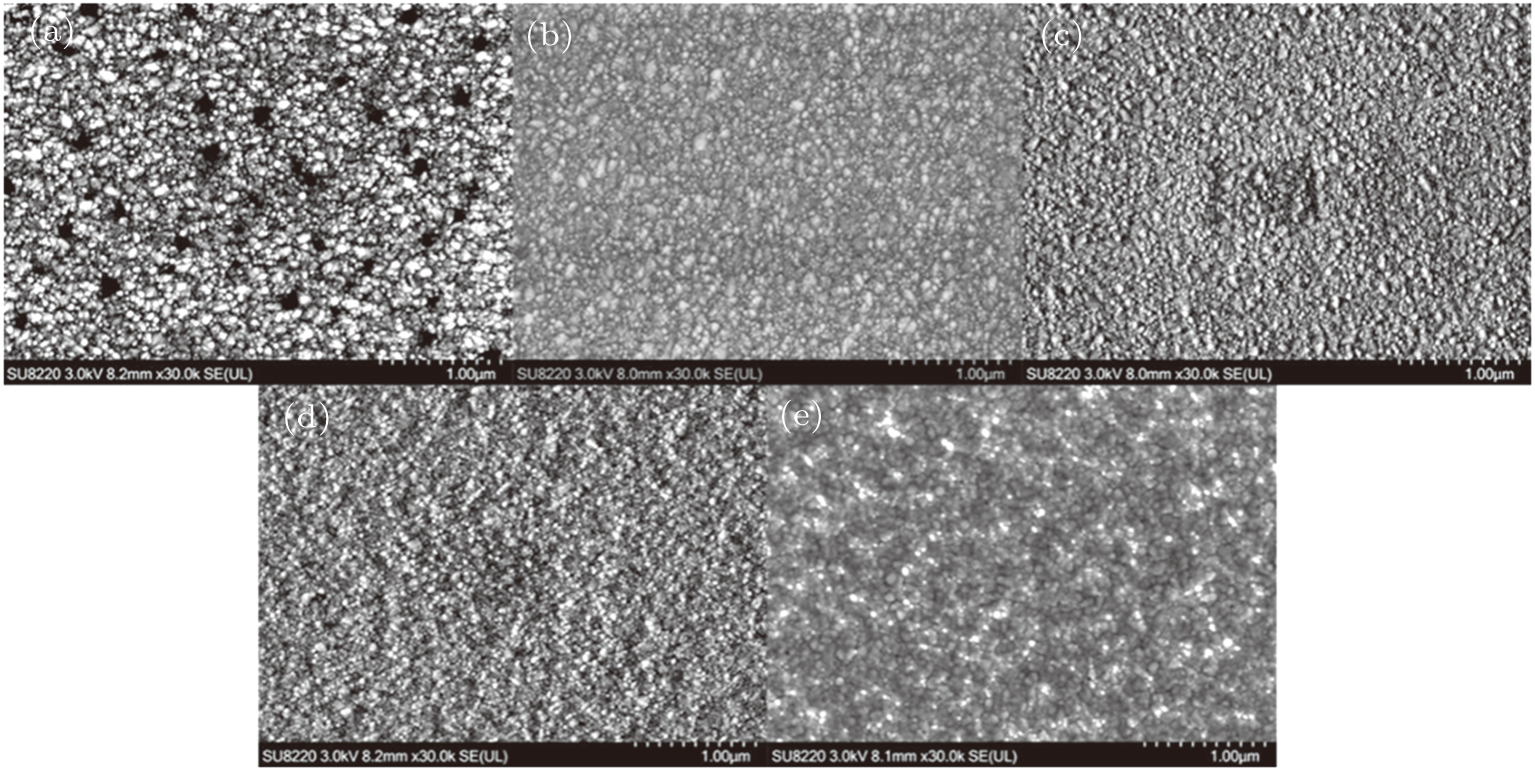† Corresponding author. E-mail:
Project supported by the National Natural Science Foundation of China (Grant No. 11574221) and the Graduate Student’s Research and Innovation Fund of Sichuan University, China (Grant No. 2018YJSY008).
Fe2+:ZnSe thin films are prepared on sapphire substrate at room temperature by electron beam evaporation and then annealed in vacuum (about 1 × 10–4 Pa) at different temperatures. The influences of thermal annealing on the structural and optical properties of these films such as grain size and optical transmittance are investigated. The x-ray diffraction patterns show that the Fe2+:ZnSe thin film is preferred to be oriented along the (111) plane at different annealing temperatures. After the film is annealed, the full-width-at-half-maximum ( FWHM ) of the x-ray diffraction peak profile (111) of the film decreases and its crystal quality is improved. Scanning electron microscope images show that the films are more dense after being annealed. Finally, the sample is used as a saturable absorber in ZBLAN fiber laser. The annealed Fe2+:ZnSe thin films can be used to realize stable Q-switching modulation on ZBLAN fiber laser. The results demonstrate that the Fe2+:ZnSe thin film is a promising material for generating the high-power pulses of mid-infrared Q-switched fiber lasers.
Transition metal (TM)-doped II–VI chalcogenides (such as Fe2+:ZnSe and Cr2+:ZnSe), as important mid-infrared laser materials, have the advantages of ultra-wideband gain, low saturation intensity, and large pump absorption coefficient.[1] They have aroused widespread interest in the scientific community.[2–7] Solid-state infrared lasers based on these materials reveal a wide tuning range, narrow linewidth, high energy, high output power, and high damage threshold.[1,7] The are widely used in biomedicine, laser spectroscopy, and space communications.[8–10] Among these materials, Fe2+:ZnSe is an important mid-infrared material for the research of optoelectronic devices and lasers.[1,11] Fe2+:ZnSe is not only a very excellent medium infrared laser material, but also an ideal passive saturable absorber.[12]
Typical saturable absorbers such as two-dimensional (2D) materials,[13–17] Cr4+-doped crystals,[18,19] gold nanobipyramids (G-NBPs),[20] and Cr2+-doped chalcogenide crystals[21] have been widely studied. As a saturable absorber, the working wavelength range of the Fe2+:ZnSe laser is 2.5 μm–4.0 μm. Recently, the Fe2+:ZnSe crystal saturable absorber (SA) for the passively Q-switching of fiber lasers has been reported to have working wavelengths around 3 μm[22] and 2.8 μm.[23] Furthermore the Fe2+:ZnSe thin film for passively Q-switched fiber laser has been reported.[24,25] Compared with its bulk crystal SA, the Fe2+:ZnSe thin film SA is easy to integrate on the optical element, resulting in a compact laser with fewer optical components. The properties of films are closely related to the methods by which they are prepared. The common preparation methods are electron beam evaporation,[26] pulsed laser deposited,[25] molecular beam epitaxy (MBE),[27,28] and chemical vapor deposition (CVD),[13] of which electron beam evaporation has the advantages of accurate electron beam positioning, fast evaporation rate, and less pollution. Annealing temperature is an important parameter for high-quality Fe2+:ZnSe thin film prepared by electron beam evaporation at room temperature, which is used as an SA. Thus, we study the properties of Fe2+:ZnSe thin films at different annealing temperatures and the modulation of laser is taken as an element.
In this work, the Fe2+:ZnSe thin films are fabricated by electron beam evaporation at room temperature and vacuum annealing is performed at different temperatures for 600 min. Through analyzing the x-ray diffraction (XRD), Raman spectrum, optical transmittance, scanning electron microscope (SEM) micrographs, the structural and optical properties before and after the annealing treatment are studied, which can be used to compact the mid-infrared Q-switched fiber lasers, since these parameters play an important role in selecting laser materials.
The Fe2+:ZnSe thin films were deposited on sapphire substrates by an electron beam evaporation system. The sapphire substrate (20 mm in diameter) is thoroughly washed with a plasma cleaner. The ZnSe and Fe powder (high purity, 99.99%, Sigma–Aldrich Co., Ltd.), placed in two separated crucibles, was used as an evaporation source in our method. The chamber pressure was kept as high as 4 × 10–4 Pa and substrate temperature was at room temperature. Deposition rate and film thickness were maintained and monitored using SQC-310 rate controller (INFICON) and a quartz crystal monitor.
The Fe2+:ZnSe thin films were annealed in vacuum (about × 10–4 Pa) at temperatures ranging from 100 °C to 400 °C for 600 min. The morphologies and structures of these films were determined by SEM, XRD, and Raman spectra. The optical transmissions of these films in a wavelength range of 1000 nm–5000 nm were measured by Fourier transform infrared spectrometer (Bruker, Tensor27), and the films were also employed in Q-switched fiber lasers. Finally, the thin film with good performance (400 °C) was used for implementing the Q-switched modulation on a ZBLAN fiber laser.
The SEM is utilized for studying the surface morphologies of Fe2+:ZnSe thin films annealed at different temperatures. Figure
The x-ray diffractions of as-deposited and annealed Fe2+:ZnSe thin films are studied. The XRD patterns are shown in Fig.


The lattice spacing d is determined from the following Bragg’s formula:



 | Fig. 2 (a) XRD patterns and (b) Raman spectra of Fe2+:ZnSe films annealed at different temperatures. |
| Table 1. Structural parameters for (111) peak of Fe2+:ZnSe films annealed at various temperatures. . |
The Raman spectra for Fe2+:ZnSe thin films at different annealed temperatures are shown in Fig.
The information about optical transmittance is of great significance for assessing the optical properties of Fe2+:ZnSe thin film. The transmission spectra of the Fe2+:ZnSe thin film in a wavelength range of 1000 nm–5000 nm at different annealing temperatures are drawn in Fig.
The Fe2+:ZnSe thin film annealed at 400 °C is used for implementing the Q-switched modulation on a ZBLAN fiber laser in Fig.
 | Fig. 5 Typical Q-switched pulse trains at output power of (a) 316 mW, (b) 660 mW, (c) single pulse waveform, and (d) average output power varying with pump powers. |
In order to observe the stability of Fe2+:ZnSe film Q-switched fiber laser, the RF output spectrum of Q-switched fiber laser with average output power of 660 mW is measured with an oscilloscope. As shown in Fig.
The pulse duration and repetition rate of the Fe2+:ZnSe thin film based Q-switched fiber laser versus pump power are shown in Fig.
The Fe2+:ZnSe thin films are prepared by the electron beam evaporation at an ambient temperature and annealed at different temperatures in vacuum for 600 min, and the effects of annealing treatment on structure, optical properties, and modulation properties are investigated. The XRD analyses and Raman spectra show that the annealing treatment can improve the crystallization performance of Fe2+:ZnSe thin film. The SEM images show that the surface of the film is smoother and denser after being annealed. Annealing temperature plays an important role in controlling modulation parameters, structural and optical properties. The annealed Fe2+:ZnSe thin films, used as a saturable absorber, can realize stable Q-switching modulation on ZBLAN fiber laser. The Fe2+:ZnSe thin film is a promising material for generating the high-power pulses of mid-infrared Q-switched fiber lasers.
| [1] | |
| [2] | |
| [3] | |
| [4] | |
| [5] | |
| [6] | |
| [7] | |
| [8] | |
| [9] | |
| [10] | |
| [11] | |
| [12] | |
| [13] | |
| [14] | |
| [15] | |
| [16] | |
| [17] | |
| [18] | |
| [19] | |
| [20] | |
| [21] | |
| [22] | |
| [23] | |
| [24] | |
| [25] | |
| [26] | |
| [27] | |
| [28] | |
| [29] | |
| [30] | |
| [31] | |
| [32] | |
| [33] | |
| [34] | |
| [35] | |
| [36] | |
| [37] | |
| [38] | |
| [39] | |
| [40] |






